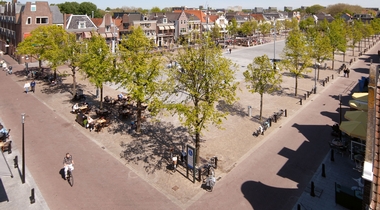Roermond
Client
Surface
- 0,57 ha
Year of design
- 2018 - 2019
Year of fulfilment
- 2020 - 2020
Activities MTD
refurbishment of the square, reconstruction of the medieval monastery garden
Munsterplein and its surroundings form the historic heart of Roermond with a rich history of buildings on and around the square with the 800-year-old Munsterkerk as a religious icon and national monument.
In 2018, MTD landscape architects received the assignment from the municipality to jointly with all users and stakeholders (participation process with various sounding board groups) make a quality improvement for the public space that does justice to the cultural-historic values and at the same time improve the use and experience value of the city center.
Additional objectives were to strengthen the green character of the square, the surroundings of the church and the rectory in order to obtain more biodiversity in the city ('nature-inclusive public space') and to provide solutions for climate issues such as preventing flooding, heat stress. and to improve the growing conditions for existing and new 'greenery'. Design proposals have also been made for the choice of materials for surfacing and street furniture and lighting that are in line with the sustainability objectives of the municipality. All this has led to an integrated design with maximum support from all parties and users involved and within the available resources. The redesign of the square was carried out in 2020, just before the 800th anniversary of the Munsterkerk and in 2021 the square was used for the TV musical The Passion.
Specifically, a reconstruction has taken place of the sunken medieval cloister garden (Abdijtuin) on the south side of the church. This garden area is still on the original medieval level and has always been used as a herb and utility garden. This severely neglected garden has been restored with a mix of herbs and medicinal plants, which also offer scent, color and experience in all seasons. These plants also provide food for insects and birds. In combination with new art and new seating furniture, it forms a calm and green oasis in the hectic pace of the city.
From the perspective of sustainability, climate adaptation and preservation of the cultural-historical character of the square, the aim is to reuse the old granite boulders that used to be on the square. Initially this was difficult because the walkability of the boulders was too poor. In the design, however, it was proposed to reuse these boulders, and by sawing off the top 2 cm a flatter surface was created and the boulders were sorted according to their width so that the joints could be made narrower (=better walkable) during re-paving. It has also been proposed to use a half-open joint filling so that rainwater can drain into the subsoil, so that the rainwater sewer is not extra burdened. This also makes the infiltrated rainwater available to the existing lime trees around. In addition to sustainable use of the pavement, efforts have been made to use sustainable materials for furniture (including modified wood) and energy-efficient lighting. An old, sick tree, which unfortunately had to be cut down, has also been reused in an art object in the monastery garden.






















